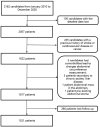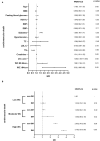Risk for Cardiovascular Death Associated With Waist Circumference and Diabetes: A 9-Year Prospective Study in the Wan Shou Lu Cohort
- PMID: 35557528
- PMCID: PMC9086628
- DOI: 10.3389/fcvm.2022.856517
Risk for Cardiovascular Death Associated With Waist Circumference and Diabetes: A 9-Year Prospective Study in the Wan Shou Lu Cohort
Abstract
Background: It has been reported that obesity and diabetes are both risk factors for the development of cardiovascular diseases (CVDs). However, recent articles reported that compared with body mass index, waist circumference (WC) can better reflect obesity, more closely related to visceral fat tissue which is positively associated with an increased risk of cardiovascular death. Moreover, few studies have investigated the prognostic value of both WC and diabetes during a long-term follow-up. We aimed to investigate whether the higher level of WC measurements and diabetes were able to predict cardiovascular mortality in the general population.
Methods: In this prospective cohort study, a total of 1,521 consecutive subjects free of clinical CVD were included. The endpoint was cardiovascular death. The Kaplan-Meier method and Cox regression models were used to evaluate the cumulative risk of the outcome at different WC levels with or without diabetes.
Results: During a median follow-up of 9.2 years, 265 patients died due to cardiovascular conditions. Kaplan-Meier survival estimates indicated that the patients with higher levels of WC (WC > 94 cm) coexisted with diabetes had a significantly increased risk of cardiovascular death (log-rank p < 0.05). After adjustment for potential confounders, multiple COX regression models showed that the incidence of cardiovascular death was significantly higher when patients with high WC coexisted with diabetes mellitus (hazard ratio: 3.78; 95% CI: 3.35-3.98; p < 0.001).
Conclusion: Patients with high WC and diabetes represent a high-risk population for cardiovascular death. WC and diabetes may provide incremental prognostic value beyond traditional risks factors.
Keywords: cardiovascular death; cardiovascular-outcome; diabetes; obesity; waist circumference.
Copyright © 2022 Li, Zhu and Wang.
Conflict of interest statement
The authors declare that the research was conducted in the absence of any commercial or financial relationships that could be construed as a potential conflict of interest.
Figures




Similar articles
-
Waist circumference is associated with major adverse cardiovascular events in male but not female patients with type-2 diabetes mellitus.Cardiovasc Diabetol. 2020 Mar 25;19(1):39. doi: 10.1186/s12933-020-01007-6. Cardiovasc Diabetol. 2020. PMID: 32213183 Free PMC article.
-
[Body mass index, waist circumference and waist-to-height ratio associated with the incidence of type 2 diabetes mellitus: a cohort study].Zhonghua Yu Fang Yi Xue Za Zhi. 2016 Apr;50(4):328-33. doi: 10.3760/cma.j.issn.0253-9624.2016.04.009. Zhonghua Yu Fang Yi Xue Za Zhi. 2016. PMID: 27029364 Chinese.
-
Different Weight Histories and Risk of Incident Coronary Heart Disease and Stroke: Tehran Lipid and Glucose Study.J Am Heart Assoc. 2018 Feb 10;7(4):e006924. doi: 10.1161/JAHA.117.006924. J Am Heart Assoc. 2018. PMID: 29440011 Free PMC article.
-
A prospective study of waist circumference trajectories and incident cardiovascular disease in China: the Kailuan Cohort Study.Am J Clin Nutr. 2021 Feb 2;113(2):338-347. doi: 10.1093/ajcn/nqaa331. Am J Clin Nutr. 2021. PMID: 33330917
-
Waist circumference and waist-to-hip ratio as predictors of cardiovascular events: meta-regression analysis of prospective studies.Eur Heart J. 2007 Apr;28(7):850-6. doi: 10.1093/eurheartj/ehm026. Epub 2007 Apr 2. Eur Heart J. 2007. PMID: 17403720 Review.
Cited by
-
Effect of a Nutrition Education Program on Knowledge, Attitudes, and Dietary Practices, Anthropometry, and Hemoglobin in Peruvian Adolescents.J Multidiscip Healthc. 2025 Mar 19;18:1679-1693. doi: 10.2147/JMDH.S507564. eCollection 2025. J Multidiscip Healthc. 2025. PMID: 40125305 Free PMC article.
-
Opposite outcomes of triglyceride-glucose index and associated cardiovascular mortality risk in type 2 diabetes mellitus participants by different obesity criteria.Sci Rep. 2025 Jan 16;15(1):2198. doi: 10.1038/s41598-024-78365-8. Sci Rep. 2025. PMID: 39820085 Free PMC article.
-
Obesity accelerates cardiovascular ageing.Eur Heart J. 2025 Jun 16;46(23):2161-2185. doi: 10.1093/eurheartj/ehaf216. Eur Heart J. 2025. PMID: 40197620 Free PMC article. Review.
-
Waist Circumference and Body Mass Index as Predictors of Disability Progression in Multiple Sclerosis: A Systematic Review and Meta-Analysis.J Clin Med. 2024 Mar 18;13(6):1739. doi: 10.3390/jcm13061739. J Clin Med. 2024. PMID: 38541964 Free PMC article. Review.
-
BMI, waist circumference, and waist-to-hip trajectories and all-cause, CVD, and cancer mortality by sex in people without diabetes.Int J Obes (Lond). 2025 Jul;49(7):1363-1372. doi: 10.1038/s41366-025-01778-6. Epub 2025 Apr 9. Int J Obes (Lond). 2025. PMID: 40204962
References
LinkOut - more resources
Full Text Sources
Miscellaneous

